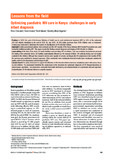| dc.contributor.author | Cherutich, P | |
| dc.contributor.author | Inwani, I | |
| dc.contributor.author | Nduati, RW | |
| dc.contributor.author | Mbori-Ngacha, DA | |
| dc.date.accessioned | 2013-06-10T11:10:42Z | |
| dc.date.available | 2013-06-10T11:10:42Z | |
| dc.date.issued | 2008-02 | |
| dc.identifier.citation | Bull World Health Organ. 2008 Feb;86(2):155-60. | en |
| dc.identifier.uri | http://www.ncbi.nlm.nih.gov/pubmed/18297171 | |
| dc.identifier.uri | http://erepository.uonbi.ac.ke:8080/xmlui/handle/123456789/30677 | |
| dc.description.abstract | PROBLEM:
In 2003, the goal of the Kenyan Ministry of Health was to avail antiretroviral treatment (ART) to 50% of the estimated 250 000 eligible individuals by the end of 2005. By July 2005, 45 000 adults and more than 2000 children were on treatment. A study was conducted to determine the barriers to identification of HIV-infected children.
APPROACH:
Existing government policies were reviewed and the ART register of the Kenya National AIDS Control Programme was used to identify facilities providing ART. This paper reports the findings around diagnosis and staging of HIV infection in children.
LOCAL SETTING:
At the time of the study, 58 health facilities were providing ART to children. Only one institution had achieved universal HIV testing in the antenatal clinics. Six facilities systematically followed up HIV-exposed children. HIV antibody testing was not readily available to the children. Although four research centres were capable of carrying out diagnostic HIV polymerase chain reaction (PCR), the services were restricted to research purposes. Other constraints were inadequate physical infrastructure, inadequate systems for quality control in the laboratories and shortage of staff.
LESSONS LEARNT:
The policy framework to support identification of HIV-infected children had been established, albeit with narrow focus on sick children. The assessment identified the weaknesses in the structures for systematic diagnosis of HIV through laboratory or clinical-based algorithms. The researchers concluded that health staff training and implementation of a systematic standard approach to identification of HIV-infected children is urgently required. | en |
| dc.language.iso | en | en |
| dc.publisher | University of Nairobi. | en |
| dc.title | Optimizing paediatric HIV care in Kenya: challenges in early infant diagnosis | en |
| dc.type | Article | en |
| local.publisher | Department of Paediatrics and Child Health, Univeristy of Nairobi, Kenya | en |
| local.publisher | National AIDS/STD Control Programme, Ministry of Health, Nairobi, Kenya | en |


